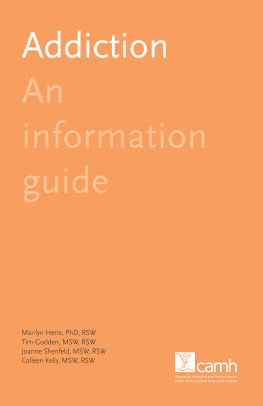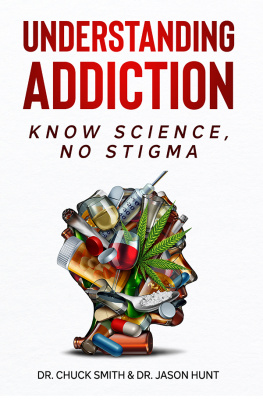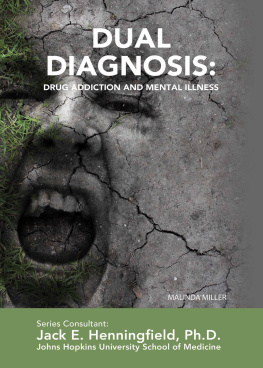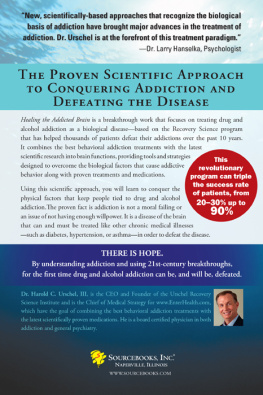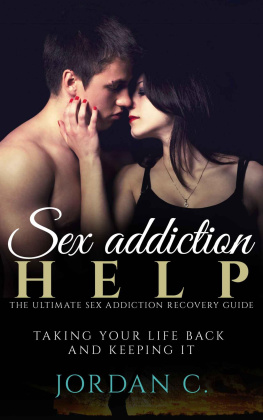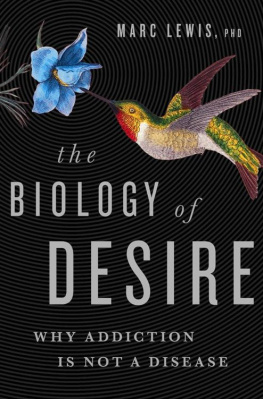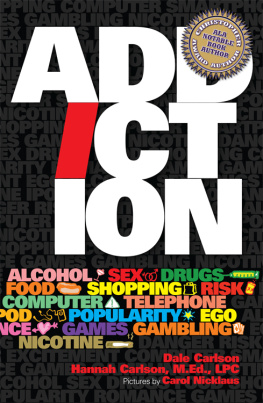Understanding Addiction
Understanding Health and Sickness Series
Miriam Bloom, Ph.D.
General Editor
Understanding Addiction
Elizabeth Connell Henderson, M.D.

www.upress.state.ms.us
Copyright 2000 by University Press of Mississippi
All rights reserved
Manufactured in the United States of America
08 07 06 05 04 03 02 01 00 4 3 2 1

The Twelve Steps and excerpts from pages 1617 of the book, Alcoholics Anonymous, are reprinted with permission of Alcoholics Anonymous World Services, Inc. (A.A.W.S.). Permission to reprint the Twelve Steps and these excerpts does not mean that A.A.W.S. has reviewed or approved the contents of this publication, or that A.A.W.S. necessarily agrees with the views expressed herein. A.A. is a program of recovery from alcoholism only use of the Twelve Steps and these excerpts in connection with programs and activities which are patterned after A.A., but which address other problems, or in any other non-A.A. context, does not imply otherwise.
Illustrations by Regan Causey Tuder.
Library of Congress Cataloging-in-Publication Data
Henderson, Elizabeth Connell.
Understanding addiction / Elizabeth Connell Henderson.
p. cm.(Understanding health and sickness series)
Includes bibliographical references and index.
ISBN 1-57806-239-X (cloth : alk. paper)ISBN 1-57806-240-3
(pbk. : alk. paper)
1. Compulsive behavior. 2. Substance abuse. 3. Dual diagnosis.
4. Addicts. I. Title. II. Series.
RC533.H465 2000
362.29dc21 00-042856
British Library Cataloging-in-Publication Data available
Contents
Introduction
Who has woe? Who has sorrow? Who has strife? Who has complaints? Who has needless bruises? Who has bloodshot eyes?
Those who linger over wine, who go to sample bowls of mixed wine.
Do not gaze at wine when it is red, when it sparkles in the cup, when it goes down smoothly!
In the end it bites like a snake and poisons like a viper.
Your eyes will see strange sights and your mind imagine confusing things.
You will be like one sleeping of the high seas, lying on top of the rigging.
They hit me, you will say, but Im not hurt! They beat me, but I dont feel it! When will I wake up so I can find another drink?
Proverbs 23:2935, New International Version
Addiction is nothing new, as we can see from the above quotation, in which the biblical writer paints a hauntingly accurate picture of the devastation caused by alcohol addiction. Alcoholism, drug addiction, and addictive behaviors affect every group at every level in our society. In the United States, one out of four people has a parent, child, or sibling who is addicted. In 1995 the National Institutes of Health estimated the economic cost of alcohol and drug abuse at over $240 billion. Lost productivity, illness, premature death, and health care expenditures are all part of this picture, as are costs associated with motor vehicle accidents and with crime and incarceration. The emotional and social damage is immeasurable. Abuse of alcohol and drugs disrupts personal development, relationships, and families, corrupting the very fabric of society. Addiction to nicotine is a problem of massive proportions, and the difficulty of shaking that habit is familiar to millions. Behavioral addictions include pathological gambling and sex and compulsive overeating. Most of us are affected, directly or indirectly, by addiction or its consequences on others.
We are familiar with the image of the skid row wino and the strung-out junkie, but addicts dont usually look or behave like that; they are more likely to resemble your next-door neighbor. They are often accomplished people, and many have achieved fame. In recent years, public figures have become more open about their problems with addiction. Betty Ford, the wife of former president Gerald Ford, struggled with alcoholism, then dedicated her life to establishing an addiction treatment center. Golfer John Daly also talked of his problems with alcoholism, as did the baseball hall of famer Mickey Mantle before his death from the physical consequences of addiction.
Our knowledge of the biology of addiction has grown tremendously in recent years. We have learned that the addicted brain does not function normally and that it is impossible to separate the brains biological function from a persons psychology and will. Clinicians who treat addiction know that there is no one perspective or approach that is correct. Recovery for addicted people and their families involves physical healing, behavioral changes, relational reconciliation, and psychological and spiritual growth. This book brings those various aspects together to provide the reader with a useful working understanding of the problem of addiction and a basis for continued learning.
As a practicing psychiatrist and addiction specialist, I believe that arming the patient and family with information about an illness is essential for success in treatment. It is wise to know your enemy. In this book, I will attempt to provide a comprehensive overview of the problem of addiction from several perspectives, including that of the addict, the addicts family, and the treating clinician. As you learn about addiction, you will find that there are no simple answers and no routine cases.
I begin by answering the question What is addiction? When does casual use become something more? How much is too much? Why are some people able to drink socially and maintain control, while others become alcoholics? Why cant the alcoholic or addict just straighten up and exert some will power? How is it that some people can just put it down while others continue to the point of destruction or death?
After discussing who gets addicted and why, I explain the biological basis of addiction and just what it is that makes a substance addictive. I look at a typical course of addiction and explore the pathway to recovery. Since addiction affects the whole family, I describe how family members can help. I explore the topic of recovery, discussing some of the techniques and strategies that are used to help addicts. Sometimes a psychiatric disorder or severe mental illness coexists with addiction, and I look at the problems that accompany such a dual diagnosis. Pathological gambling, sexual addiction, and other compulsive behaviors that are behavioral addictions are also discussed. Because addiction is a major personal, family, and social problem, it is being studied in many laboratories, and I end the book by reporting on promising new research. The appendices give some history on the regulation of addictive substances and provide sources for further information.
When people discuss addiction, they often assume that there is a difference between alcoholism and addiction to other drugs. Although some important differences between alcohol addiction and drug addiction do exist, there are many similarities. When I examine the basic nature of addiction, alcohol and drugs are considered interchangeable, and the term addict is used to denote both the alcoholic and the drug addict, because the basic biological and psychological processes of addictive disease are the same for both.
As a result of the social changes that occurred during the 1960s and 1970s, it is more common than it was in earlier times for people to have used multiple drugs in addition to alcohol. The social and demographic differences between alcoholics and drug addicts have also diminished. But the basic nature of addiction is the same across categories of substances and shares common characteristics with compulsive behavior disorders such as pathological gambling. I will point out any important differences among substances; otherwise the reader may assume that the point being made regarding one could apply to any other.
Next page

